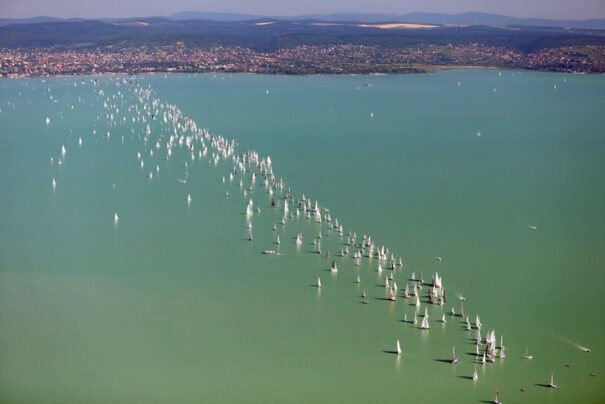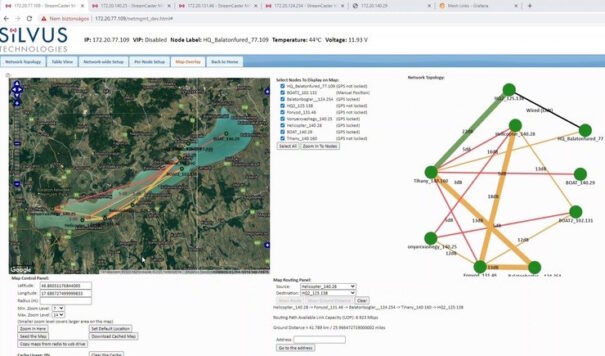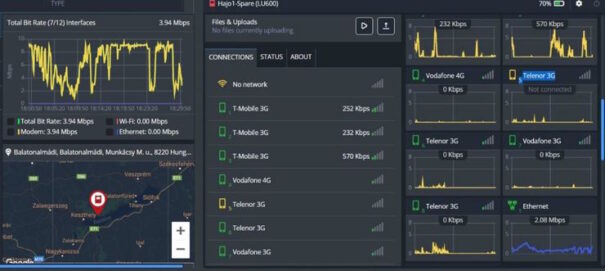Broadcast Solutions Hungary cubre la regata en el lago Balaton con una red Silvus MESH
El objetivo principal de esta experiencia ha sido demostrar que el sistema podía cubrir todo el lago (600 km² con una longitud máxima de 80 km) utilizando una red Silvus MESH con sólo 6 radios en tierra, 2 en barcos y 1 unidad en un helicóptero.
Lo que inicialmente se planificó como una prueba de concepto (POC) para mostrar las capacidades de una red MESH que proporcionaba conexión a Internet a cámaras inalámbricas en la Blue Ribbon – Vuelta al lago Balaton en Hungría, se convirtió en el cambio de juego para el broadcaster nacional húngaro con su canal M4 Sport in situ para asegurar conexiones de señal estables para la emisión en directo.
La Blue Ribbon, la regata interior más larga del mundo, es una carrera de vela alrededor del lago de aproximadamente 155 km de longitud con más de 600 embarcaciones diferentes que viene celebrándose todos los años desde 1934.
Broadcast Solutions Hungary puso a prueba una red MESH para la transmisión en vivo desde las cámaras inalámbricas de las embarcaciones y alrededor del lago, lo que subraya la superioridad de las redes MESH independientes de la infraestructura existente en la transmisión en directo durante una producción real.
Cubrir la acción en el lago debido a su gran extensión es como trabajar en el mar con cámaras instaladas en barcos, helicópteros y en diferentes lugares de la costa. Las soluciones de transmisión inalámbrica estándar dependen de la infraestructura de una red móvil existente (3G/4G/5G), que es difícil de encontrar en algunos lugares, y a menudo se congestiona en los momentos más críticos. Las redes MESH Silvus por radio ofrecen algunos beneficios significativos en términos de ancho de banda y cobertura al establecer una red dedicada.
Durante la preparación de la POC y las pruebas de campo de la red MESH antes de la carrera, quedó claro que incluso si hay visión directa entre las unidades inalámbricas, la mayoría de las ondas de radio son absorbidas por el agua. Debido a este hecho físico, el equipo de Broadcast Solutions instaló algunas radios en las colinas y torres de vigilancia situadas alrededor del lago.
De esta manera, los ingenieros instalaron una red que alcanzó más de 43 kilómetros con una capacidad de enlace UDP de 5 Mbps usando sólo 4 antenas bBi Omni de radio Silvus Streamcaster 4200, desde la torre de vigilancia de Alsóörs hasta el mirador de Fonyód.
Red Silvus MESH
El objetivo principal de esta experiencia era demostrar que el sistema podía cubrir todo el lago (600 km² con una longitud máxima de 80 km) utilizando una red Silvus MESH con sólo 6 radios en tierra, 2 en barcos y 1 unidad en un helicóptero que funcionaba perfectamente.
En la salida de la carrera se hizo rápidamente evidente, que la red común utilizada por el broadcaster llegó a sus límites y falló debido a las redes congestionadas, con un gran número de espectadores y las largas distancias que necesitaban cobertura. La carrera comenzó, las redes móviles se cayeron, y no había suficiente conexión celular ni siquiera con 8 unidades de unión de tarjetas SIM, y la transmisión en vivo falló.
Ese fue el punto en el que el equipo de Broadcast Solutions GovCom subió el listón. Con sólo algunos ajustes en los parámetros, instalando dos antenas sectoriales adicionales, una radio más, y finalmente inyectando la Internet a la red, establecieron una red estable y en funcionamiento Silvus MESH.
Al otro lado del lago, cada unidad de enlace celular combinada con una radio Silvus obtuvo una alimentación adicional de Internet, independientemente de su débil conexión a la red celular. Todas las unidades de enlace unidas a una radio Silvus fueron capaces de transmitir imágenes en vivo sin importar si estaban en el aire o en el lago. Toda la carrera y la transmisión en vivo fue bien, y el espectáculo se salvó.
Related posts:
El valor de la producción original en 4K como elemento diferenciador
9,7 millones de espectadores siguieron el 'Cara a Cara' entre Rajoy y Sánchez
Primera emisión en vivo a 360º con LifeSphere
Movistar+ y telemundo cierran un acuerdo estratégico de corproducción
YouTube y Universal Music remasterizarán un millar de icónicos videoclips
AJA helps Pass get started in audiovisual hosting and streaming
Did you like this article?
Subscribe to our NEWSLETTER and you won't miss anything.





